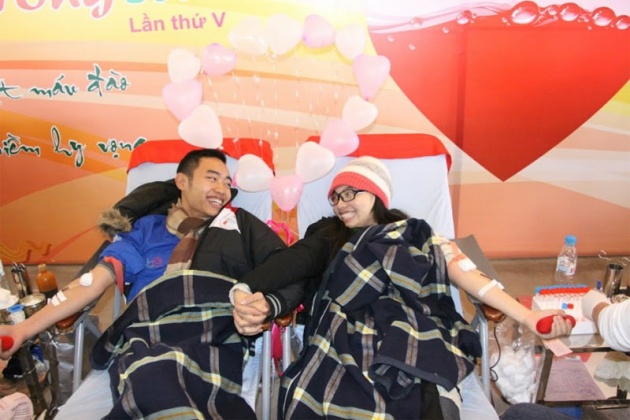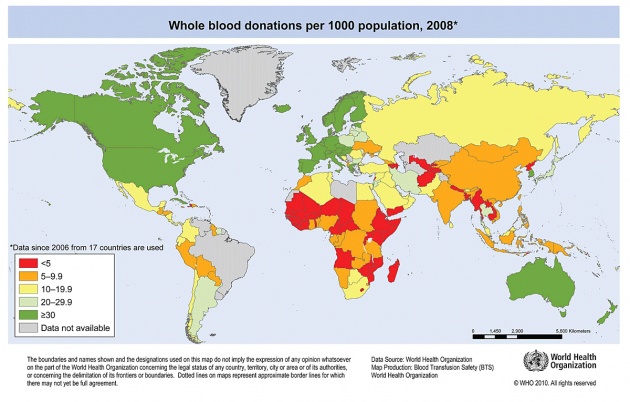
May surprise how much of our healthcare is dependent on blood, and thus the donations of volunteers around the globe. Accidents and disasters are only part of the need. “With increasing life expectancy and the subsequent increase in the number of age-related, chronic diseases, including cancers, that require blood and blood products for treatment, demand outstrips supply,” the Coordinator for Blood Transfusion Safety at the World Health Organization, Dr. Neelam Dhingra, “In addition, some blood products used to treat cancer patients, like platelets, have a shelf-life of only five days. This means we increasingly need more blood donors to meet these demands.”

Below is link to UN’s World Health Organization & the Press Statement - http://www.who.int/mediacentre/news/releases/2012/blood_donation_20120614/en/index.html
Above UN Photo (Vietnam) - A young couple are one of 500 others who gave blood at the Pink Spring Festival in Ha Noi, Viet Nam. Photo: Viet Nam National Institute of Haematology and Blood Transfusion.

Ambassador Muhamed Sacirbey - FOLLOW mo @MuhamedSacirbey
Facebook-Become a Fan at “Diplomatically Incorrect”
Twitter – Follow us @DiplomaticallyX
See more at our Popular Video Blogs & Current News Event Articles – www.diplomaticallyincorrect.org

More voluntary blood donations essential
On World Blood Donor Day, WHO calls for more people to be heroes – donating blood regularly
News release
14 June 2012 | Geneva - Every year, millions of people rely on the generosity of another person to donate blood. Yet, blood donation rates vary considerably and the demands for blood and blood products are increasing worldwide. To meet these needs, more people must come forward to give blood voluntarily, and regularly, says the WHO on World Blood Donor Day.
“With increasing life expectancy and the subsequent increase in the number of age-related, chronic diseases, including cancers, that require blood and blood products for treatment, demand outstrips supply,” says Dr Neelam Dhingra, Coordinator for Blood Transfusion Safety at WHO. “In addition, some blood products used to treat cancer patients, like platelets, have a shelf-life of only five days. This means we increasingly need more blood donors to meet these demands.”
Need for blood and blood products is rising
The need for blood and blood products is rising in all parts of the world. In high- and middle-income countries, with advancements in health-care systems and improved health coverage, this need is being driven by increasingly sophisticated medical and surgical procedures such as cardiovascular and transplant surgery, trauma care and therapy for cancer and blood disorders. All major surgeries need blood to be available on standby.
In addition, severe bleeding during delivery or after childbirth is the leading cause of maternal mortality worldwide. When severe bleeding occurs, urgent and timely treatment is required for management of these patients, including transfusion of blood and blood products, as women may die within one hour.
Every year, road traffic accidents cause 1.3 million deaths globally and, in addition, injure or disable between 20 million and 50 million people; 90% of deaths from road traffic accidents occur in developing countries. Uncontrolled bleeding accounts for more than 468 000 deaths per year.
In low-income countries where diagnostic facilities and treatment options are limited, the majority of transfusions are prescribed for the treatment of complications during pregnancy and childbirth, the management of severe childhood anaemia, trauma and congenital blood disorders. In many situations, current systems are unable to meet the needs, while expansion of health coverage and improved access to health services further increases these demands.
More repeat donors are essential
There are 92 million blood donations per year globally, most of these by voluntary, unpaid donors. But of these voluntary donors, 30 million give blood once, and then do not return.
“We need to encourage these donors to come back and become repeat, regular donors,” says Dr Dhingra. “Each blood donation is only 450 millilitres and by having more repeat voluntary donors, we can better assure the reliability of blood supply and safety of blood and blood products.”
Country successes
Yet, there are some noteworthy examples of countries who are able to meet the transfusion needs of their health-care systems, and WHO is highlighting these successes on this World Blood Donor Day.
Today, 62 countries meet their transfusion needs and many more are making rapid progress. For example, Viet Nam has increased voluntary blood donation from just one third of total supplies to almost 90% in just 10 years. It has also increased total annual blood collection from 268 394 units to 776 420 units in the same period.
In the Cook Islands, education campaigns targeting health workers and the community have resulted in a complete change in the source of blood donations: from 2002 to 2007, the proportion of blood collected from voluntary, unpaid donors increased from 30% to 100%. It also increased the number of regular donors from just 70 to more than 400 donors from its population of around 20 000.
For more information please contact:
Gregory Härtl
WHO Media coordinator
Telephone: +41 22 791 4458
Mobile: +41 79 203 6715
E-mail: hartlg@who.int
Tarik Jasarevic
WHO, Geneva
Telephone: +41 22 791 5099
Mobile: +41 79 367 6214
E-mail: jasarevict@who.int



